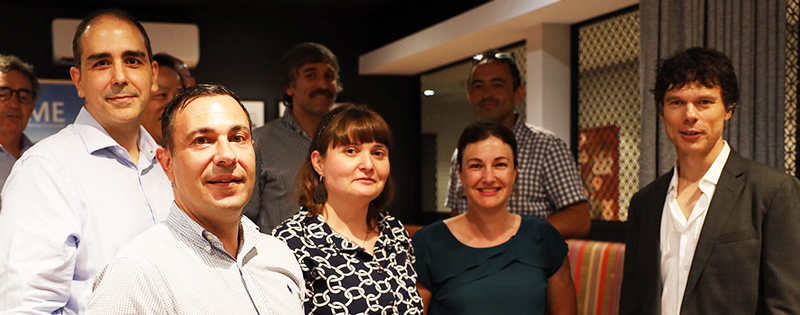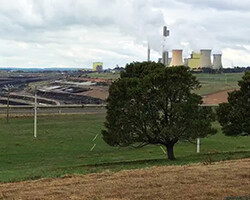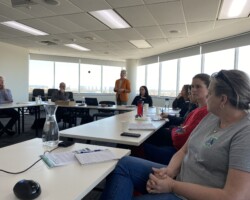What’s new?
- Education – meet our new PhD scholars
- #CreatingConnections2021 Forum
- CRC TiME Seminars
- Upcoming Conferences
- Project Spotlight:
- Regional Hubs update
- Interested in becoming a Partner
From our CEO…
As we approach the end of 2021, we have been faced with a challenge that I think speaks volumes about our progress as an organisation and partnership; what do we leave out of the newsletter?
We recently released our Strategic Plan, outlining seven strategic goals critical to successfully transforming our mining economies to deliver a positive legacy beyond the mine. This was complimented by our first Annual Report which highlights our key achievements over the past year and is testimony to the hard work of our partners, team and Board!
Over the last few months we have started to see a steady increase in key learnings from our inaugural investment in the Foundation Portfolio, with six reports released and others on their way. We also initiated a new project on Understanding Local Readiness for Closure, based around MMG’s Rosebery Mine in Tasmania. Last month we also ran our inaugural CRC TiME Annual Forum which provided a platform for our project leaders to share their progress and featured leading presentations from industry, government, regional communities.
Finally, as we approach 2022 we are delighted to welcome four PhD students to the CRC TiME family. I congratulate them on their scholarships and look forward to sharing their journey. With best wishes for the holiday season.
We were delighted to announce four new scholarship recipients of our HDR scheme (Higher Degree by Research) -Benedictor Kemanga, Amelia Lee Zhi Yi, Maryam Sadat Kahe and Babul Hossain. They will complete their PhD’s on specific industry defined issues and are embedded within CRC TiME partner organisations. Their research areas range from soil carbon sequestration, pit lake and ground water systems to stakeholder mapping.
Read more about their ground-breaking work at: https://lnkd.in/g25kPxmD
#CreatingConnections2021 Forum
 The inaugural CRC TiME #CreatingConnections2021 Forum for partners was held across three days in November and December. With over 70 partner organisations across six stakeholder groups, it was a tremendous opportunity to come together virtually, share knowledge, and contribute to the development of new projects. The Hon. Keith Pitt, Minister for Resources and Water opened the Forum and reminded attendees how closure for one company may be a beginning for another.
The inaugural CRC TiME #CreatingConnections2021 Forum for partners was held across three days in November and December. With over 70 partner organisations across six stakeholder groups, it was a tremendous opportunity to come together virtually, share knowledge, and contribute to the development of new projects. The Hon. Keith Pitt, Minister for Resources and Water opened the Forum and reminded attendees how closure for one company may be a beginning for another.
A key theme to emerge from the Forum was that if people are going to support mines coming online, they need to be confident that those mines will be responsibly closed. This includes if there are changes in financial or environmental circumstances and mines need to close early. By thinking about closure earlier, it allows for planning to enable better outcomes for communities. There is a key insight here: not planning for closure leads to missing out on the benefits of effective closure – there is an opportunity cost.
Both WA and QLD were fortunate to be able to host Forum networking drinks. The opportunity to connect stakeholders in a casual, face to face environment was a privilege we took advantage of. In case you’d like to refresh your memory or couldn’t make it, you can view the photos below.

QLD Networking Event (L to R): Santiago and Jorge from Rio Tinto; Lavinia from CSIRO, Emma from QLD Govt mine rehabilitation commissioner office, and Tom from CRC TiME
 WA Networking Event
WA Networking Event
View all Forum networking photos
CRC TiME partners Mine Land Rehabilitation Authority and Federation University Australia for hosted an in-person and virtual seminar on integrating values in post-mining transitions. Guest speaker Karsten Feucht, from IBA spoke on the redevelopment and landscape transformation experience post brown coal mining in Lusatia, Germany.
Some important conferences on the horizon are calling for abstracts:
- The International Conference on Acid Rock Drainage (ICARD) abstracts deadline been extended to 21 January, 2022 for their virtual #ICARD2022 event in September, 2022
- Mine Closure 2022 is being held in Brisbane from 4-6 October 2022 with abstracts due 5 April 2022
- The 26th World Mining Congress is being held 26-29 June 2023 in Brisbane. CRC TiME is hosting a Special Symposium on Mine Closure and Post-Mining Transitions will take place on the second day of the Congress, Wednesday, 28 June, 2023. It will be an all day joint session between the Environmental Sustainability Stream and the Social Performance & Governance Stream. Submissions of abstracts are encouraged by 31 March 2023.
 Around the world, many towns and regions have been founded and developed because of mining activity. When that activity dwindles or ceases altogether, the impact on local communities is complex and multi-faceted. Populations shift, economic linkages change, services adapt, and people’s historic, cultural, familial, and emotional ties to place may be impacted. The impact of mine closure on the immediate community and broader region will be contingent to a large extent upon their dependency on the mine and the existence of alternative social and economic opportunities and structures.
Around the world, many towns and regions have been founded and developed because of mining activity. When that activity dwindles or ceases altogether, the impact on local communities is complex and multi-faceted. Populations shift, economic linkages change, services adapt, and people’s historic, cultural, familial, and emotional ties to place may be impacted. The impact of mine closure on the immediate community and broader region will be contingent to a large extent upon their dependency on the mine and the existence of alternative social and economic opportunities and structures.
To uphold equity and inclusiveness, decisions around closure planning need to ensure that the interests and views of all affected communities are considered. This project proposes to test, analyse, and share an existing participatory methodology (the Town Transition Tool or TTT) as a first step to understanding local readiness for closure and building a long-term participatory approach to mine closure planning. In Phases I and II of this project the TTT will be applied in the context of MMG’s Rosebery Mine in Tasmania, and the results of the process shared with CRC TiME partners and stakeholders interested in mine closure more broadly.
Sarah Mackenzie, Project Leader
 General industry feedback arising from Project 2.3 highlighted a number of deficiencies in the way in which the minerals industry assesses and analyses mine closure, notably from an identification as well as from a quantification standpoint. That is, while all of the regulated closure requirements are typically addressed, the award of a final closure certificate remains elusive, largely because there may still be ‘something residual’ that has not been addressed or may not yet be known that needs to be addressed.
General industry feedback arising from Project 2.3 highlighted a number of deficiencies in the way in which the minerals industry assesses and analyses mine closure, notably from an identification as well as from a quantification standpoint. That is, while all of the regulated closure requirements are typically addressed, the award of a final closure certificate remains elusive, largely because there may still be ‘something residual’ that has not been addressed or may not yet be known that needs to be addressed.
The consensus view is that the industry has a sound grasp on the tangible risks (known knowns) aligned with mine closure and its commensurate pre-planning, has a lesser grasp on both the tangible uncertainties (known unknowns) and the intangible risks (unknown knowns), but is completely in the dark around intangible uncertainties. The fundamental problem with intangible uncertainties is that, as it relates to mine closure, we do not know what may arise in the future and we have no idea of how to accommodate what we do not know. It’s an unknown unknown paradigm, that remains somewhat elusive at this stage, and will be the focus of future research in this programme.
Eric Lilford, Project Leader
Project 3.7 : Comparative Closure: Assessing the biophysical closure challenges of different mining methods
 Closure issues vary depending on the mining method, which creates different biophysical challenges on the surface and in underground mining operations. On the other hand, mining methods depend on the geology of the ore deposit. Usually, the method is selected based on pre-feasibility studies and there is limited opportunity to change the mining method once implemented.
Closure issues vary depending on the mining method, which creates different biophysical challenges on the surface and in underground mining operations. On the other hand, mining methods depend on the geology of the ore deposit. Usually, the method is selected based on pre-feasibility studies and there is limited opportunity to change the mining method once implemented.
If the ability to close the mine, re-use the landscape and contribute to the community are to become driving factors in selecting the mining method and mine operations, then they should also be considered early in the pre-feasibility study decision making.
Current mining methods can be environmentally disruptive due to the required footprint for processing and storing the waste material. Large-scale gangue movement and treatment drives operating costs and set higher cut-off grades, which requires the mining methods to produce at an economy of scale. Novel mining methods have been proposed to address these impacts. Because these methods require the use of alternative technologies, such as robotics, leaching and cutting, they introduce a different set of biophysical issues that may affect closure and post-mining land use. So is this tradeoff worth it? There is a need to quantify the biophysical impact of different mining methods. In this project, we present a method of analysis based on a matrix approach, which allows for a comparative assessment of biophysical risk and opportunity across different mining methods.
Ralph Picorelli, Project Leader
 Recently, members of Regional Hubs were given opportunities to connect with each other, sharing their local experiences with regions across the country. Regions are often at different stages of the closure process but share many characteristics or challenges from which others can benefit.
Recently, members of Regional Hubs were given opportunities to connect with each other, sharing their local experiences with regions across the country. Regions are often at different stages of the closure process but share many characteristics or challenges from which others can benefit.
The CRC TiME Forum session on ‘regional hub story sharing’ provided a platform for 5 Hub Chairs to discuss local barriers and opportunities. Afterwards, a Regional Hub round table, attended by hub secretariats was convened to discuss challenges related to the establishment of hubs and ways that hubs could support one another going forward.
A number of face to face and online workshops have also been held in regional hub areas in order to ensure locally relevant project ideas are developed. Face to face workshops were held in South West Western Australia and Bowen Basin Queensland to brainstorm new project ideas. Similarly, an online workshop was held with Latrobe Valley stakeholders to gain support for a hub and to discuss potential project ideas related to stakeholder engagement. Early next year, a face to face workshop is planned for Gove in the NT.
If you would like to engage with the ideas development process in Hub regions please contact your local hub secretariat or email emma.yuen@crctime.com.au
Interested in becoming a Partner?
 We are actively seeking indigenous partners to join CRC TiME and partners to co-invest in our emerging projects community groups around our Regional Hub areas. Join the growing number of stakeholders collaborating with us to find practical solutions to the multi-faceted issues surrounding mine closure.
We are actively seeking indigenous partners to join CRC TiME and partners to co-invest in our emerging projects community groups around our Regional Hub areas. Join the growing number of stakeholders collaborating with us to find practical solutions to the multi-faceted issues surrounding mine closure.
If your organisation would like to become part of this globally significant effort to improve lives, communities, the environment and industry, please contact guy.boggs@crctime.com.au or phone 08 9263 9805.
We welcome hearing and sharing updates from our partners. Contact jane.stacey@crctime.com.au with your news.
We acknowledge the traditional custodians across all the lands on which we live and work, and we pay our respects to Elders both past and present.



